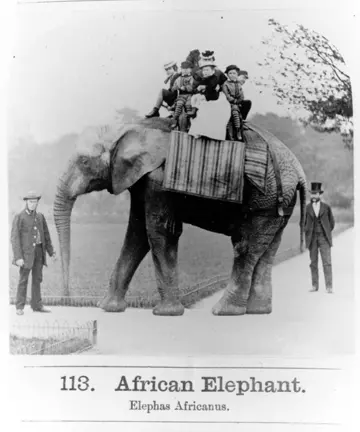
ZSL
Zoological Society of London
This month's guest blog is by Camille Regnault, UCL Student.
According to the author John Sutherland, ‘Baby Jumbo’s exact place and date of birth is vague’. Like Disney’s eponymous hero Dumbo, ‘he might as regards the genealogical record have been brought in by the stork'.*
It is widely agreed that the young calf and his mother inhabited the border regions between Abyssinia and the Sudan (what is now modern Eritrea). Sutherland writes that Jumbo’s birthdate is ‘most reliably put at sometime between early 1860, or shortly thereafter’.
One irrefutable detail concerning Jumbo’s early life is that of his arrival at London Zoo on the 26th June 1865.
The book of Daily Occurrences
This event is immortalised in the book of Daily Occurrences, held at the ZSL Library, which is one of few original documents to chart the male African elephant’s humble beginnings.

The former was completed daily and listed the arrivals and departures of animals at London Zoo and Whipsnade, featuring a log entry for one particular ‘African elephant’ (Loxodonta africana) that was successfully acquired from the Jardin des Plantes in Paris, at the cost of a ‘few Rhinoceroses’.
Like a zoological register of civic life, it also documented the births and deaths of the animals (marriages were not recorded though Jumbo was later famed for successfully entering married life with a female elephant named Alice).
As such, the Daily Occurrences provides an invaluable record of zoo life during the Victorian age. As Fischer points out ‘while the London Zoo itself did not officially open to the general public until 1846, different species of animals became commonplace and familiar through the press. No longer known as merely abstract symbols, such animals commanded tremendous fascination. The animals gradually became what is popularly termed ‘zoo pets’; animals so well known as to be anthropomorphised and adopted. In this adoption, the danger that such wild animals present became ignored in a kind of mass denial’^
‘Jumbo’ he goes on to say ‘represents the zenith of all this… Through his enormous size (eleven feet tall), he became an English icon. He, as all male elephants do, underwent musth, and became quite aggressive in 1881. The zoo was forced to sell him for a mere £2000. The public outcry against the sale was unprecedented.’

Jumbo was not least welcome because he presented a rare opportunity for Bartlett to study the animal up close and pay particular attention to the elephant’s habits and treatment in captivity. This commitment to his research lead him to publish papers in the Proceedings of the Zoological Society and other journals, some of which can be viewed today at the ZSL Library.
References mentioned in the text:
* Sutherland, J. (2014). Jumbo: The Unauthorised Biography of a Victorian Sensation. London: Aurum Press. p28.
^ Fischer, J. K. (1997). The Transparent Aviary: A Zoo Allegory. London: Architectural Association School of Architecture. p29-31.
* Bartlett, A. D. (1899). Wild Animals in Captivity. 3rd ed. London: Chapman & Hall. p23-24.
^ Bartlett, A. D. (1899). Wild Animals in Captivity. 3rd ed. London: Chapman & Hall. p44-45.
Additional reading:
Autobiography of Matthew Scott, Jumbo's keeper: also Jumbo's biography (1885) / Matthew Scott, [Whitefish, Mont.] : Kessinger, [2012]
Elephant story: Jumbo and P.T. Barnum under the big top / by Les Harding, Jefferson ; London: McFarland & Co, 2000
Jumbo / W. P. Jolly, London: Constable, 1976
Jumbo : the greatest elephant in the world / Paul Chambers, London : Andre Deutsch, 2007
London Zoo from Old photographs 1852-1914 - 2nd ed. / by John Edwards, London : John Edwards, 2012. Includes all know photographs of Jumbo.
